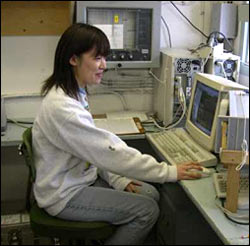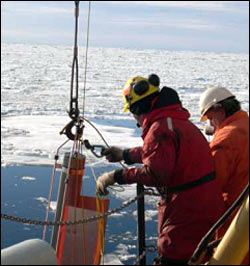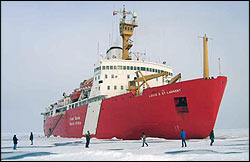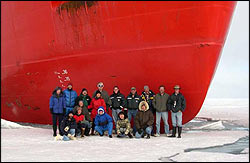Please note: You are viewing
the unstyled version of this website. Either your browser does not support CSS
(cascading style sheets) or it has been disabled. Skip
navigation.
Rick KrishfieldAugust 26-27, 2004
In addition, another mooring which had been deployed two years ago by IOS and JAMSTEC scientists was recovered yesterday. This mooring goes by the acronym PITSA, and included an upward looking sonar for ice draft measurements, an ADCP current profiler, and an underwater thermistor string. Unlike the WHOI moorings which use wire rope, the PITSA mooring used Kevlar cable to be lightweight in case it would be recovered from an ice camp instead of a ship. The drawback to the Kevlar cable is that it can be broken by sharp ice, so Doug Sieberg and the Deck Crew used extra care when retrieving the PITSA mooring. Fortuitously, we also found an ice mass balance buoy that was deployed last year but stopped signaling. The system was laying sideways in a melt pond with the antenna underwater which explains why it could not communicate. Designed to be expendable, this is the first time that one of these systems will be brought for the scientists at CRREL to examine. But it's not all work. Last weekend, when the Chief Scientist and Captain deemed that we had a little extra time, the ship pulled up next to a large icefloe, the gangplank was lowered, and everyone who wanted to was allowed to walk on the ice for a few hours. There was also a celebration on the 22nd to commemorate the 10th anniversary of the cruise that this ship took to the North Pole along with the US Coast Guard Icebreaker Polar Sea. In addition, another polar bear was spotted, and the cribbage tournament continues.
Last updated: October 7, 2019 | ||||||||||||||||||||
Copyright ©2007 Woods Hole Oceanographic Institution, All Rights Reserved, Privacy Policy. | ||||||||||||||||||||






